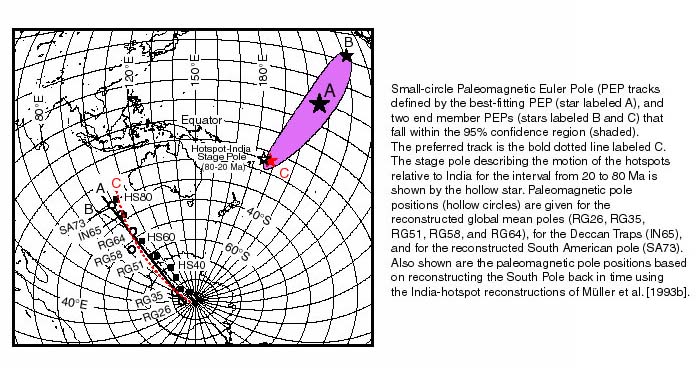Apparent Polar Wander of India Since the
Cretaceous With Implications for
Regional Tectonics and True Polar Wander
Published in Memoir Geological Society of India, No. 44, p. 129-175, 1999.

Abstract
We use global paleomagnetic data to construct an apparent polar wander
path (APWP) for India than spans the past 75 m.y. The total uncertainties
for each paleomagnetic pole include not only those uncertainties related
to the determination of the pole, but also those related to reconstruction
uncertainties that accumulate as these poles are rotated into the Indian
plate reference frame. Comparison of poles from the rest of the globe with
paleomagnetic data from the Indian plate, which are comprised of one paleomagnetic
pole from the Deccan Traps and 44 paleocolatitude data from DSDP and ODP
drill sites, show good agreement. As apparent in past compilations, this
new APWP indicates that India has moved progressively northward since the
Late Cretaceous, with the rate of motion being more rapid in the Late Cretaceous
and Paleogene than before or after this period. The preferred South Pole
APWP for India during the Cenozoic roughly follows the 100°E meridian,
west of that shown in other recent compilations. Because the paleomagnetic
data indicate that the trend of the APWP has been fairly constant over
tens of millions of years, we investigate fitting the data to a small-circle
track as defined by the paleomagnetic Euler pole (PEP) model. A single
PEP track spanning the interval from about 20 to 75 Ma can be found that
is consistent with 18 out of 19 of the reconstructed paleomagnetic poles
and the Deccan Traps pole. The location of the preferred PEP is at 14°S,
186°E, defining a small-circle South Pole APWP that is 77.8° angular
distance away. The location of the PEP is consistent with the position
of the reconstruction (stage) pole that describes the motion of the hotspots
relative to India for the interval from 80 to 20 Ma. Furthermore, extrapolation
of the PEP track back in time shows that it also provides an excellent
fit to paleomagnetic data back to 120 Ma. At its young end, the track passes
to within 2° of the South Pole. Hence, one small-circle track fits
paleomagnetic data for a period spanning the past 120 m.y. Using a maximum
likelihood algorithm and the 25-73 Ma paleomagnetic data, we estimate that
the rate of APW along the track must have had an abrupt decrease at 57±3
Ma, which is thought to correspond to when the collision or suturing of
India with Eurasia began to impede India's northward progression. Overall,
the rate of APW along the PEP track can be well modeled with three rate
changes- 73, 57, and 20 Ma-over the 120 m.y. interval. Estimated rates
are 0.6°/m.y. (66 km/m.y.) for the interval from 120 to 73 Ma; 1.9°/m.y.
(211 km/m.y.) for the interval from 73 to 57 Ma; 0.9°/m.y. (95 km/m.y.)
for the interval from 57 to 20 Ma; and 0.1°/m.y. (11 km/m.y.) for the
interval from 20 Ma to the present. Given these rates along the PEP track,
the reconstructed global paleomagnetic poles are on average within 4.7°
of the coeval paleomagnetic pole predicted by the preferred PEP. Correction
of the global paleomagnetic poles for a 5% geocentric axial quadrupole
component reduces this average distance to 4.6°, illustrating the robust
nature of an APWP derived from global data and the good fit of the PEP
model to these data. Finally, reconstruction of mean global poles and the
PEP derived APWP into the hotspot reference frame allows for generalizations
to be drawn concerning true polar wander (TPW). First, over the past 75
m.y., TPW as constrained by the hotspot APWP can be divided into three
intervals (75-40, 40-20, and 20-0 Ma) defining small-circle tracks separated
by cusps. Second, the rate of TPW appears to be particularly slow from
55 to 40 Ma, averaging 0.15°/m.y. (17 km/m.y.), whereas the rate varies
little in other intervals, averaging a nearly constant rate of 0.40°/m.y.
(44 km/m.y.). The accuracy of such generalizations concerning TPW is hampered,
however, by the relatively large uncertainties associated with hotspot
reconstructions and paleomagnetic data in relation to the slow rate of
TPW. Within these uncertainties, TPW may have been small and perhaps negligible
since the Late Cretaceous.
Return to Gary Acton's
Hompage
